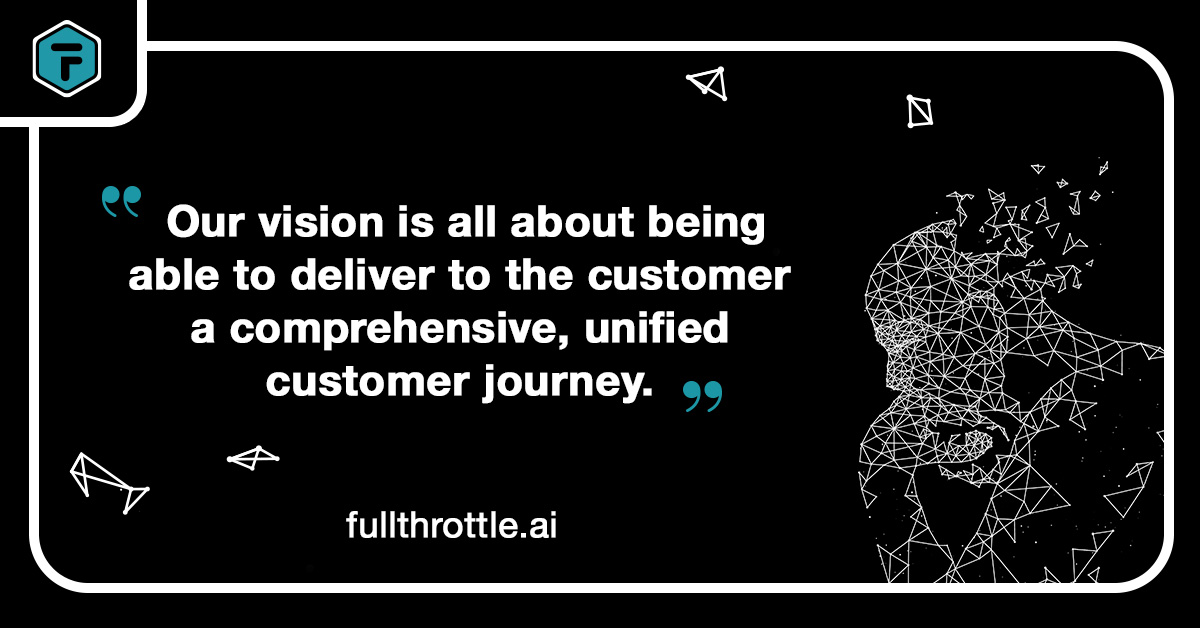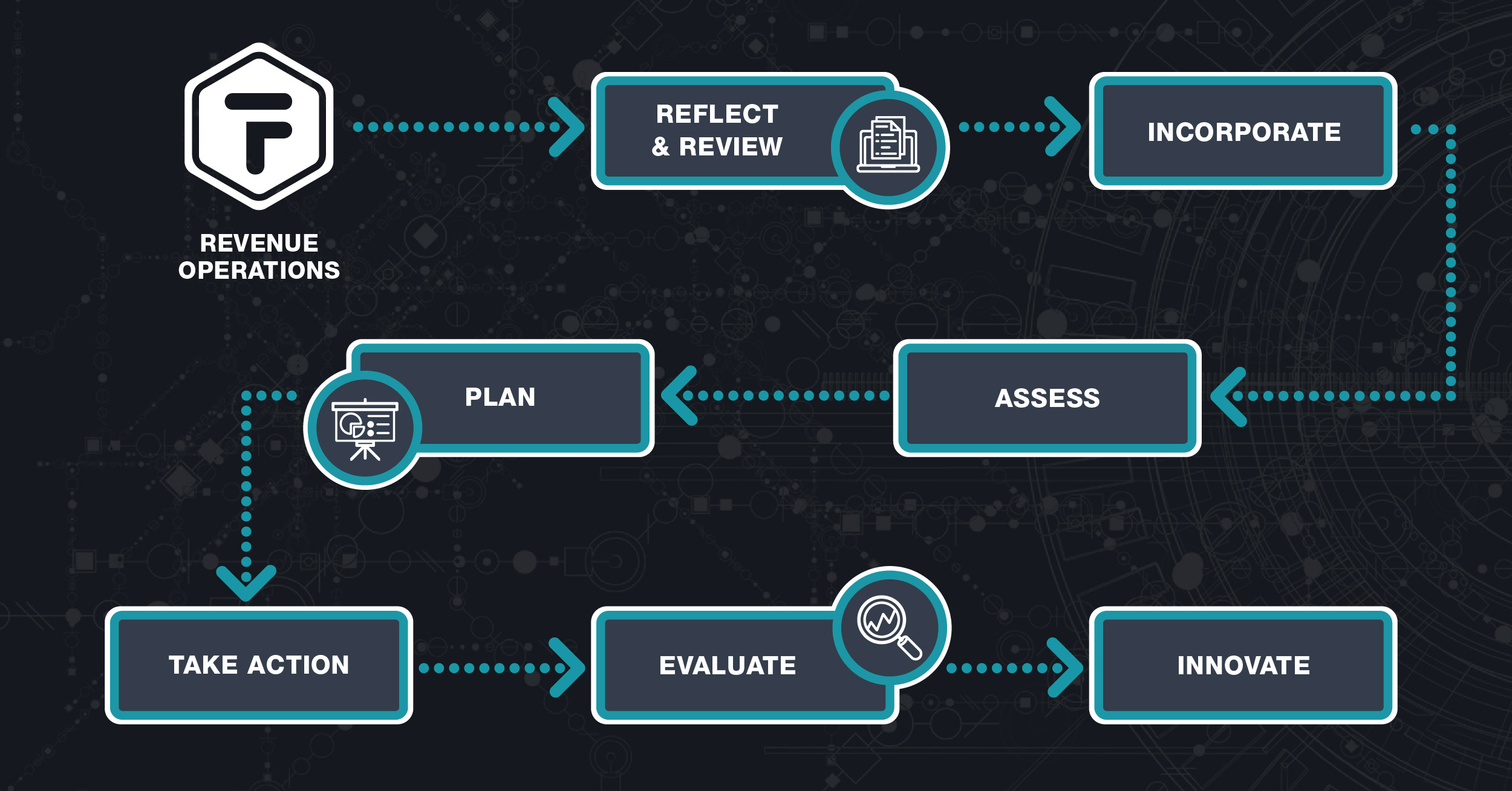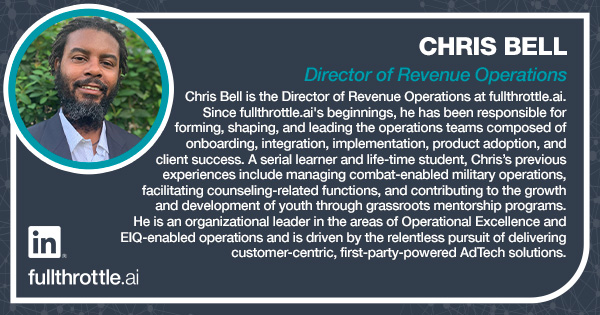
What Makes fullthrottle.aiTM Strong and Unique
Our company is only as strong as the people who work here. Our employees make our company tick as well as enable the organization, the structure, and the success of our clients. In this article, we want to showcase how things work in our day-to-day operations, which begins with our employees, their responsibilities, and how they work.
fullthrottle.ai’s Revenue Operations
Revenue Operations is ultimately responsible for client success. There are many facets within the department
The RevOps Team
To some extent, selling is easy. It’s the delivery that’s the hard part. When talking to prospects and customers, you can bring them on board because they see the value in our solution. Now, the hard part starts when you must deliver world-class customer service. Launching needs to go smoothly.
At the core, Revenue Operations is all about strategic alignment. It is the alignment of all the departments that contributes to the revenue of an organization.
There is the overall team, but there are also several groups who work together to make everything happen, which includes the Integration Team and the Optimization Team.
Our vision is all about being able to deliver to the customer a comprehensive, unified customer journey.
What Do We Mean by Alignment?
If we picture aligning, a great example would be Marketing, Sales, Customer Success, Engineering, and Professional Services all working together. Alignment in Revenue Operations is critical, since it allows us to strategize processes across all the operational functions.
Together, everything provides that comprehensive and unified customer journey.
Departments Within the RevOps Team
As mentioned previously, the Revenue Operations department is made up of different teams. This means each person on each team needs a certain background, mindset, and drive to contribute to their department’s success. The day-to-day activities of each person are completely different as well.
Altogether, it is really about delivering results to the end-customer.
What Is the Structure of the Collective Team?
Our structure is integration. Integration is really about the touchpoint between the sale and the intake. Our team is made up of client-facing personalities—people who are able to interface with our customers, talk about the technology, and help the customer understand how the solution actually solves their problem, not just how the technology works.
Someone in this position, who is customer-facing, must have a specific disposition. They need to be outgoing and highly analytical. An extremely critical component of the position is problem-solving. Critical thinking is highly sought after since a lot of the time, we have to read between the lines to make things come together. This coming together is integration.
We align our teams based on revenue streams, client types, and opportunity types. This way, we can have the right people handling these opportunities as well as offer white-glove treatment to our customers, from intake on.
Optimization
Now, flip the coin over and look at optimization. Optimization is helping to expedite lifetime value to the customer. Once they become a client, we want to supercharge our tools, so we deliver hyper-focused results.
This group is more technically sound and technically minded. They look more at code bases and how the technology actually works together with the customer in real life. They work on the behind-the-scenes deconstruction of the software, in and of itself. This group of people can talk technical, and then they can break technical phrases and terminology down for the clients.
This group also has high sleuthing tendencies. They are really focused on being able to find what’s not as obvious, to ensure we’re getting the most out of our technology. Then, they take the learnings from integration, which allows them to deliver solutions to help to grow the overall value to the customer.
That’s how we get to the lifetime value more quickly.
The Day-To-Day Revenue Operations Orchestra

A typical day is comprised of seven areas:
- Review what’s been done, where they’re at, what’s in front of them, and reflect on what has happened prior to the current engagement
- Incorporate those learnings into the present day
- Assess the strengths, weaknesses, opportunities, and threats surrounding the initiatives
- Plan for client-facing engagements and technical stability
- Take action
- Evaluate
- Innovate
As we continue to grow, we must plan on how we can maneuver, add, and supercharge software systems.
The point where the hammer hits the nail is when we take action. We take a lot of actions in this environment—not just actions that are about responding to customers but looking proactively at how we can continue to unify and deliver the best result.
The Importance of Evaluation
If we’re not looking at what’s been done before and not looking at what’s been delivered that time or as a unit, then we miss certain key performance indicators that are gleaned from those insights.
The Importance of Innovation
This is not just software innovation. Rev Ops includes innovation of thought, organization, workflows, and processes.
How Revenue Operations Supports the Overall Function of fullthrottle.aiTM
The department operates in five key areas:
- Operations and aligning. In standard terms, operations is breaking things into steps, such as one through three. However, right now, it goes deeper. It’s about aligning those operational units. Having different competencies work in parallel and tandem, which ultimately breaks down silos. Once the silos are broken down, then we can align with our goals.
- Tracking metrics. It’s important to track the same metrics. This way, we do not focus on what we believe to be important, but rather contribute to the priorities.
- Expansive enablement. This is really about ownership. The goal here is to have ownership and responsibility.
- Data. A data-driven environment is able to interpret and then glean insights from data.
- Accountability and collaboration. This is the final piece, as it’s about working towards a common goal. When you have silos reduced into the priorities of focus you are able to works towards the better buying and customer lifecycle experience.
How the Teams Interact and Come Together
fullthrottle.aiTM is a location-invisible cockpit. We are not tethered to a corporate office to deliver our work. We are reliant on technology that allows communication channels to pass information back and forth.
We also operate in a sprint mindset. Our methodology is to operate through our subscription-based products, so we built an agile methodology to allow us to do sprint planning. This brings all the departments and department heads together to look at what they are each doing in their individual area and then discuss how their departments overlap.
This is connecting the dots to the various centers. At each tier in the organization, we communicate horizontally. This creates cross-functional operations, so we can deliver more without adding more to the unit.
How Does RevOps Lead to Success for Our Clients?
By supporting and aligning the operations across all revenue functions. The department strives to connect the dots between marketing, sales, customer success, engineering, and professional services. Due to this unification, we can deliver the most precise and hyper-focused information, so the executive business can make decisions to continue to move us in the direction we’re headed.
Our Revenue Operations works hard, so your experience with fullthrottle.aiTM is simple and easy—as it should be! You should never work harder than your technology. To see how fullthrottle.aiTM provides your business white-glove service, schedule your demo here.
Learn About Our RevOps Leadership
fullthrottle.ai’s Director of Revenue Operations, Chris Bell
Our Revenue Operations leader is Chris Bell, Director of Operations. Chris was born and raised in West Philadelphia. His father never allowed him to be mediocre, so this attitude has stuck with him his whole life. Chris’s father always said:
“If you’re going to be a bum, be the best bum you can be.”
He also would tell Chris that life isn’t governed by a clock—instead, it is by a compass. We arrive where we are destined to go. This is how Chris ended up at fullthrottle.aiTM.
Prior to fullthrottle.aiTM, Chris spent 15 years in the military, with two of those years spent in combat in Iraq. Before his time in the Navy, his life was centered around music production and performance. In the ‘90s, he toured with the Wu-Tang Clan!
All his vastly diverse experiences have set him up perfectly to handle the day-to-day operations in his department.
Chris’s background and his time in the military set him up to build and structure the team in a way that allows us to handle a lot of clients quickly.
The military helped him drill in and hold his administrative and organizational skills. The military is a highly structured outfit and requires being nimble. He understands how to adapt in tense situations and adjust quickly.
Combined with that experience, he was taught to get close to administration to fully understand the way a business works. It has helped keep him grounded and understanding of all the components of the business puzzle. Having three younger brothers also taught him how to be an overseer—to speak as a teammate and as a manager. Growing up in the inner city taught him responsibilities that were applied to him at a much younger age than others in different environments. All together, these experiences have helped him relate to people. They have helped him communicate and humble himself –– to take feedback and interact with others, no matter their level.
fullthrottle.ai’s Revenue Operations Management Style
As a leader, Chris is able to instill and trickle down some of his learnings to his team to see them grow outside of their comfort zone. The skills he’s learned from his background feed into helping his team handle “live fire.”
His direct management style is the approach of teaching, coaching, directing, and delegating his basic leadership principles, leading them to success.
His management has allowed the group to take hold of concepts and become comfortable. They begin to understand that to get to any real growth, they have to step outside of their comfort zones.
Chris leads with a “bottom-up growth” mindset –– putting people in positions to leverage what they’re truly great at. That way, fullthrottle.aiTM can maneuver more organically. We grow from empowering our employees and promoting them from within.



